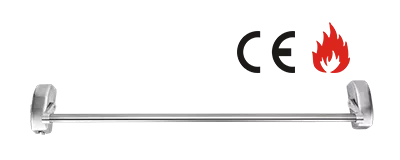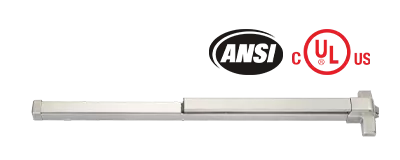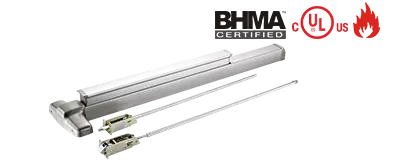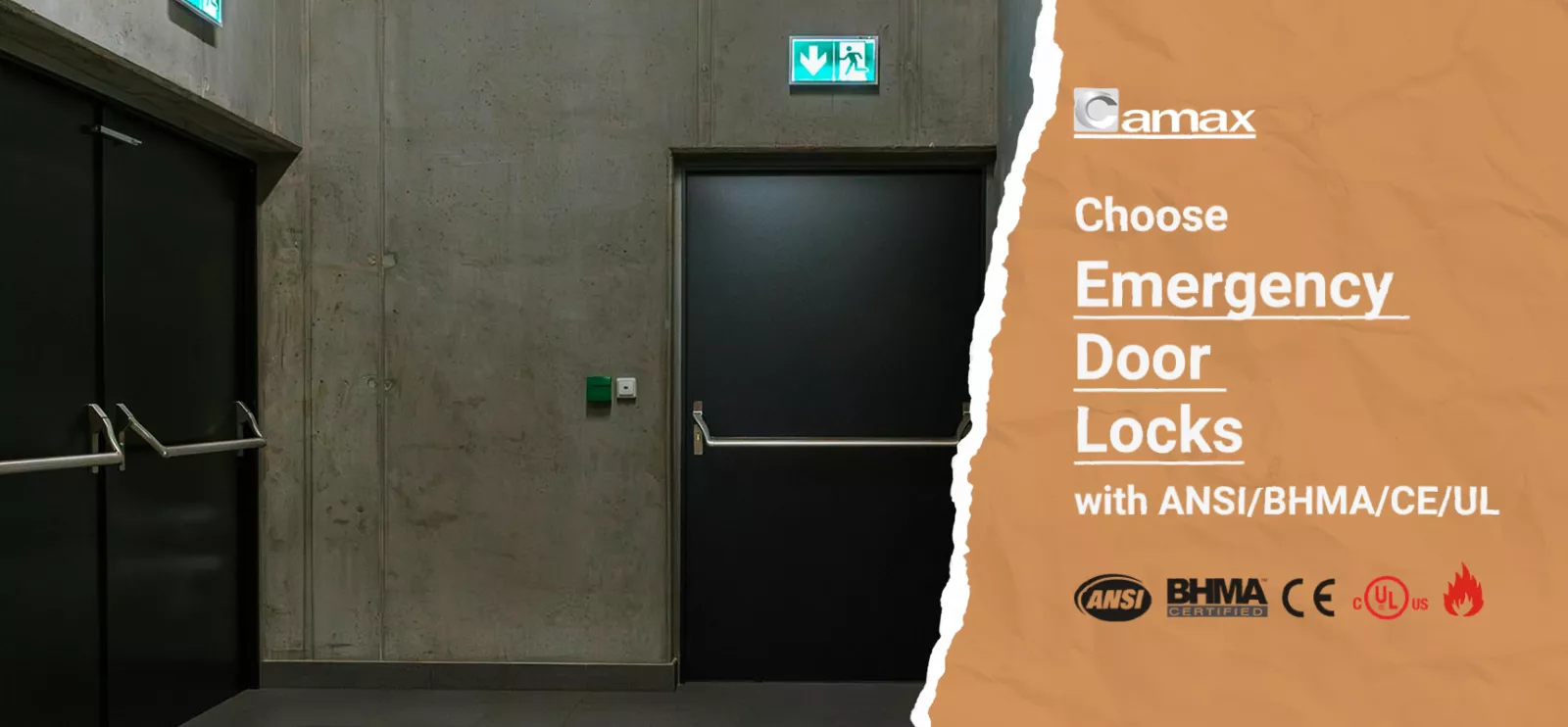
In any building—whether residential, commercial, or industrial—emergency exit door locks are crucial components for ensuring the safety of its occupants. These locks are designed to allow quick and easy exit in the event of an emergency such as a fire, earthquake, or other disasters. However, the effectiveness of an emergency door lock depends heavily on its quality and reliability. This is where certifications come into play.
Certifications like UL (Underwriters Laboratories), CE (Conformité Européenne), ANSI (American National Standards Institute), and BHMA (Builders Hardware Manufacturers Association) ensure that emergency egress locks meet rigorous safety, performance, and durability standards. In this article, we will explore why these certifications matter, what they signify, and how to identify certified exit locks to ensure that your building complies with safety regulations and protects its occupants effectively.
The Role of Emergency Exit Door Locks in Safety
Emergency door locks are critical in moments of crisis. In the event of a fire, flood, or any other emergency situation, occupants need a reliable and quick way to exit a building. This is particularly important in public places such as schools, hospitals, and office buildings where large numbers of people may need to evacuate in a short amount of time. The role of an emergency exit gate lock is to provide immediate access to safe exit routes without hindrance. These locks must be designed to prevent unauthorized entry while allowing occupants to open the door easily when necessary. Whether it's a panic bar, push bar, or electromagnetic lock, the functionality of these exit devices is paramount to the safety of individuals inside a building. However, ensuring that the locks meet safety standards is equally important. Certified emergency exit door locks provide the assurance that they have undergone rigorous testing and comply with national and international safety standards. Let’s delve into the four most important certifications that guarantee the reliability and safety of these locks.
Understanding Key Certifications for Emergency Exit Door Locks
1. UL Certification for Emergency Door Locks
UL, Underwriters Laboratories, is one of the most respected safety certification organizations worldwide. It tests products for a variety of safety concerns, including electrical, fire, and mechanical hazards. Emergency exit door locks that are UL-listed have been tested for fire resistance, durability, and effectiveness under extreme conditions. The UL 305 standard, for example, is specifically designed for panic hardware (commonly used for emergency exit doors). This certification ensures that panic bars and similar devices meet strict performance criteria, such as the ability to open the door easily under pressure, even in high-stress situations. When purchasing exit locks, UL certification signifies that the device has been tested for durability, emergency operation, low temperature impact and high environmental exposure.
2. CE Certification for Emergency Door Locks
The CE mark, Conformité Européenne, is a certification used in the European Union to indicate that a product meets health, safety, and environmental protection standards. For emergency exit door locks, the CE certification ensures that the product adheres to European Union regulations, particularly with regard to safety features and performance. For example, CE-certified exit locks comply with the European EN 179 and EN 1125 standards, which cover panic exit devices for use in commercial and public buildings. These standards set out requirements for the construction, performance, and installation of exit hardware to ensure they function properly in emergency situations. While CE certification is not globally required, it is essential for products being sold or used within the European market. For manufacturers, obtaining a CE mark assures compliance with EU directives and demonstrates commitment to product safety.
- • Narrow Stile Crossbar Exit Device
- • Handed
- • Certificate: EN1125, categoery 3; EN1634-1, 2-hour fire rated
- • Material: Stainless steel, Steel, Plastic
- • Finish: Stainless steel satin, Silver painted, Polishing, PVD, Black, Red
- • Multi-points Lock Exit Device
- • Non-handed
- • Certificate: EN1125; EN1634-1; EN12211, 6000Pa for CMP511
- • Material: Stainless steel, Steel
- • Finish: Stainless steel satin, Silver painted, Polishing, PVD, Black, Red
3. ANSI Certification for Emergency Door Locks
ANSI, American National Standards Institute, is a nonprofit organization that oversees the development of voluntary standards in the United States. For emergency exit door locks, ANSI certification is critical because it sets the performance and durability standards for locking mechanisms. ANSI's grading system, which includes Grade 1, Grade 2, and Grade 3, is often used to rate the quality and strength of locks. Grade 1 is the highest grade, indicating that the lock is capable of withstanding heavy usage and providing maximum security. Grade 2 is typically for residential and light commercial applications, while Grade 3 is for more economical and lower-use environments. The ANSI certification ensures that the lock meets specific operational and security standards, including the ability to function properly over time under various conditions. For emergency exit doors, ANSI Grade 1 locks are the most recommended because they are tested for durability and resistance to tampering.
- • Touch Bar Panic Exit Device
- • Non-handed
- • Certificate: ANSI/BHMA A156.3 grade 2; UL listed
- • Material: Stainless steel, Steel
- • Finish: Stainless steel satin, Silver painted, Polishing, PVD, Black, Red
- • CE & UL Listed Panic Touch Bar
- • Non-handed
- • Certificate: ANSI/BHMA A156.3 grade 1; UL10C, fire rated
- • Material: Stainless steel, Steel
- • Finish: Stainless steel satin, Silver painted, Polishing, PVD, Black, Red
4. BHMA Certification for Emergency Door Locks
BHMA, Builders Hardware Manufacturers Association, works in collaboration with ANSI to set standards for architectural hardware in the U.S. This certification focuses on the quality, performance, and aesthetic standards of locks and other hardware used in buildings. BHMA-certified exit locks have been rigorously tested for things like durability, wear resistance, and functionality. Like ANSI, BHMA uses a grading system to rate the quality of locks. For example, BHMA Grade 1 locks are built to withstand high traffic and harsh conditions, while lower grades are more suited to residential or light-duty applications. The BHMA certification ensures that exit door locks are robust, functional, and capable of handling the demands of high-traffic environments.
- • Heavy Duty Panic Exit Device
- • Non-handed
- • Certificate: ANSI/BHMA A156.3 grade 1; UL10C, 3-hour fire rated
- • Material: Stainless steel, Steel, Aluminum
- • Finish: Stainless steel satin, Silver painted, Polishing, PVD, Black, Red
- • Concealed Vertical Rod Exit Device
- • Non-handed
- • Certificate: ANSI/BHMA A156.3 grade 1; UL10C, 3-hour fire rated
- • Material: Stainless steel, Steel, Aluminum
- • Finish: Stainless steel satin, Silver painted, Polishing, PVD, Black, Red
Why Are Certifications Important for Emergency Exit Door Locks?
Certifications from UL, CE, ANSI, and BHMA matter for several reasons:
Reason 1: Compliance with Regulations
Many countries and localities require compliance with specific safety standards, particularly in public and commercial buildings. Certified exit locks ensure that you meet these requirements and avoid legal issues.
Reason 2: Safety Assurance
Certified locks have undergone rigorous testing to ensure they perform reliably during emergencies. They are designed to provide a smooth, hassle-free exit when needed, which can be life-saving in critical situations.
Reason 3: Reliability and Durability
Certification ensures that the lock will function as intended over time, even under heavy use. This reduces the risk of failure and ensures the longevity of the lock.
Reason 4: Reduced Liability
By choosing certified locks, building owners and managers reduce the risk of liability in case of an accident. Non-certified or subpar locks can fail to perform during emergencies, leading to injury, loss of life, or property damage.
Reason 5: Insurance Compliance
Many insurance companies require that exit devices meet certain safety standards. Choosing certified products may reduce insurance premiums or help with claims in case of an emergency.
How to Identify Certified Emergency Exit Door Locks?
Identifying a certified emergency exit door lock is easy once you know what to look for. Here are some tips:
Look for Certification Labels
Certified locks often feature labels or markings that indicate they have passed safety tests. Check for the UL, CE, ANSI, or BHMA logo on the product.
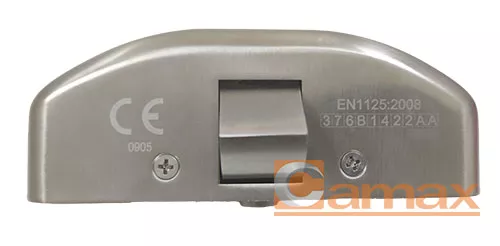
Consult Manufacturer Documentation
Reputable manufacturers provide detailed specifications for their products, including certification information. Ensure that the lock’s performance aligns with the certification standards.
Verify with Official Websites
For UL, ANSI, and BHMA certifications, you can cross-check the certification status of the product by visiting the official websites or contacting the manufacturer.
Camax Hardware: Your Trusted Manufacturer for Certified Emergency Exit Locks
When it comes to certified emergency exit door locks, Camax Hardware stands out as a reliable manufacturer committed to safety and quality. With about 20 years of expertise in producing high-quality commercial door hardware, Camax Hardware offers a wide range of emergency exit locks certified by UL, CE, ANSI, and BHMA. Camax Hardware provides a versatile range of high-quality exit device solutions designed to enhance safety and functionality in various building environments. Our offerings include touch bar exit devices for smooth and effortless operation, cross bar and push bar exit devices that combine durability with ease of use, and glass door panic devices that maintain aesthetics without compromising safety. Additionally, Camax offers locks for exit devices and trim options to provide complete, tailored solutions for emergency exit systems. These products are crafted to meet stringent industry standards, ensuring reliability and peace of mind in critical situations.
Camax Hardware ensures that every product is meticulously designed, tested, and certified to meet international safety standards. Whether you need locks for schools, hospitals, office buildings, or residential complexes, Camax Hardware provides customizable solutions tailored to your specific needs. With a focus on innovation and durability, Camax Hardware guarantees products that not only enhance safety but also provide long-lasting performance. By choosing Camax Hardware, you’re investing in a trusted partner that prioritizes the safety of your building and its occupants. Ready to upgrade your building’s safety? Explore Camax Hardware’s certified emergency exit door locks today and experience the perfect combination of quality, reliability, and compliance. Contact us now to find the right solution for your safety needs by email info@camax.cn.
Conclusion
When it comes to emergency exit doors, selecting a lock with proper certification is essential for ensuring safety and compliance. UL, CE, ANSI, and BHMA certifications guarantee that the lock will perform reliably during emergencies, providing quick and easy access to safe exits. By understanding these certifications and their importance, building owners and managers can make informed decisions that prioritize safety, reduce liability, and meet legal requirements. Choosing the right certified emergency exit door lock is an investment in the safety of building occupants. Partnering with trusted manufacturers like Camax Hardware ensures you get top-tier products that meet stringent standards. Make safety a priority today by selecting certified emergency exit locks that you can depend on during critical moments.



